KS2 SATs Maths Revision - Popular Questions
Table of Contents
As with English Reading SATs questions, while the SATs questions change each year, the curriculum, structure and format of the Maths SATs tests remain the same. The same is true with Grammar and Punctuation questions.
Remember, SATs tests check whether children can tackle particular topics as laid out in the national curriculum. Hence, it's entirely expected that while the questions may vary slightly, a number of question formats are repeated year after year.

Of course you can always look at all our worked solutions for past KS2 Maths SATs papers. These are available to download for free from this very website.
Here though, we will talk about the most common question types that pop up, and how to tackle them.
Mental Arithmetic Questions
The KS2 Maths SATs papers consist of three separate tests. Maths Paper 1 is a mental arithmetic paper, and Maths papers 2 and 3 focus on reasoning.
Hence, with 40 marks available in Paper 1, mental arithmetic forms a significant portion of the KS2 Maths SATs tests.
In this SATs paper, children solve straightforward calculation problems involving the addition, subtraction, multiplication, and division of whole numbers, decimals, fractions, and percentages.
Children should aim to achieve high marks in this highly predictable paper.
How to Answer Mental Arithmetic Questions
- Read the question carefully and double-check which operator is being used.
- Choose a method which suits the function, e.g., column addition and subtraction, the 'bus stop' method for division and long multiplication.
- Set out the calculations neatly in the squares provided.
- Always align the decimal points above/below one another for questions involving adding and subtracting decimals.
- For multiplication and division questions, it can be helpful to write out the times tables at the side of the page.
- Use the grid provided to write down all calculations (no matter how small they are).
- When the answer area says 'Show your method', ensure children show their full method!
- Always show your working – you may get a mark even if you make an arithmetic error.
- Don't be tempted to skip steps by performing mental arithmetic in your head.
- Check the answer.
- Look for any indications of a mistake, i.e., additions or multiplications should result in a larger number, and subtractions and divisions should result in a smaller number.
Example Mental Arithmetic Question
Taken from 2019 KS2 Maths SATs Paper 1, Question 6.

How to answer:
- Write out the calculation as a column addition.
- Use one square for each number and each decimal point.
- Be sure to align decimal points vertically, i.e., one on top of another.
- Fill in any 'spaces' after the decimal point with a 0 (so 5.87 becomes 5.870).
- Complete the addition as you would with any other column addition.
- Be careful to include values when 'carrying' over to another column.
- Check through workings for any errors.
- Write the final answer clearly in the blue box provided.
- Make sure that the decimal point is included in your answer.
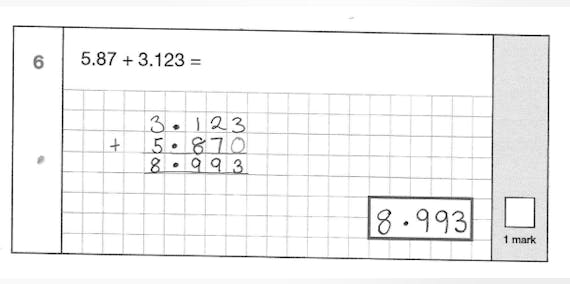
Common Pitfalls with Mental Arithmetic Questions
Most past SATs papers feature questions that move the answer box to a different position, unnerving many children (e.g. 2022 KS2 Maths Paper 1, Question 3 and Question 7).
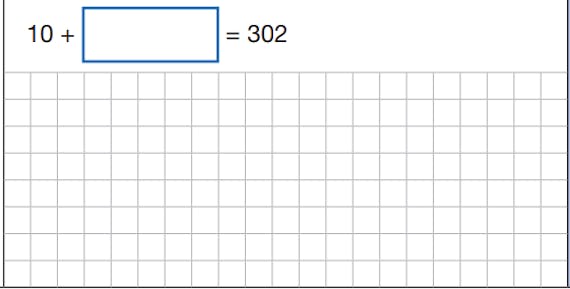
The mental arithmetic skills required to tackle these questions are no different to other questions but children should experience plenty of questions laid out in this fashion before their real SATs tests to ensure they are not confused.
Most past feature questions that ask for a portion 'of' another number (e.g. 2022 KS2 Maths Paper 1, Question 27, Question 28 and Question 30).
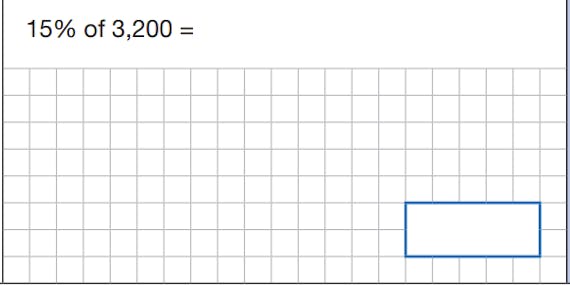
Again, the best way to stop children becoming confused is by working through all the examples that past Maths SATs papers have to offer.
Fractions, Decimals, and Percentages
Fractions, decimals, and percentages questions are always included in KS2 Maths SATs papers.
Children can be required to solve problems related to converting, comparing, and calculating fractions, decimals, and percentages.
Examples include:
- 2016 KS2 Maths Paper 2: 7a, 7b, 8, 10.
- 2016 KS2 Maths Paper 3: 5, 6, 13.
- 2017 KS2 Maths Paper 2: 6, 9, 20, 23.
- 2017 KS2 Maths Paper 3: 5, 17, 21a, 21b.
- 2018 KS2 Maths Paper 2: 4, 7, 13, 14, 23.
- 2018 KS2 Maths Paper 3: 16, 18, 19.
- 2019 KS2 Maths Paper 2: 6, 11a, 12, 15, 20, 22.
- 2019 KS2 Maths Paper 3: 4, 6, 18.
- 2022 KS2 Maths Paper 2: 6, 7, 10, 11, 16.
- 2022 KS2 Maths Paper 3: 4, 13, 16, 17.
How to Answer Fractions, Decimals, and Percentages Questions
How you answer these types of questions depends heavily on the context in which they are being used.
Your child will have been taught several techniques related to fractions, decimals, and percentages. It would be a wise use of time to spend time practising and perfecting these individual techniques before SATs.
- Fractions, decimals, and percentages are all parts of a whole number.
- Children are taught to recognise commonly occurring equivalences such as ¼ = 25/100 = 25% and 0.25.
- Being able to quickly recognise equivalencies is key to being able to answer these types of questions.
- Another common technique is to convert between fractions, decimals and percentages. E.g. 39%, 39/100 and 0.39 are all the same number.
Example Fractions, Decimals, and Percentages Question
Taken from 2022 KS2 Maths SATs Paper 3, Question 16.

How to answer:
- Calculate how many boxes are shaded, i.e., 4 × 10 = 40.
- The grid is 10 rows × 10 columns, so the total number of grid cells is 100.
- This means 40 out of 100 cells are shaded or 40/100.
- Tick the fraction 40/100.
- Check each fraction to see if it is equivalent to 40/100. To do this, children need to use their knowledge of fractions to convert each of them to have the same common denominator (100), thus allowing the fractions to be easily compared.
¼ = 25/100
2/5 = 4/10 = 40/100
4/10 = 40/100
6/10 = 60/100 - Tick the other fractions equivalent to 40/100, 4/10 and 2/5.
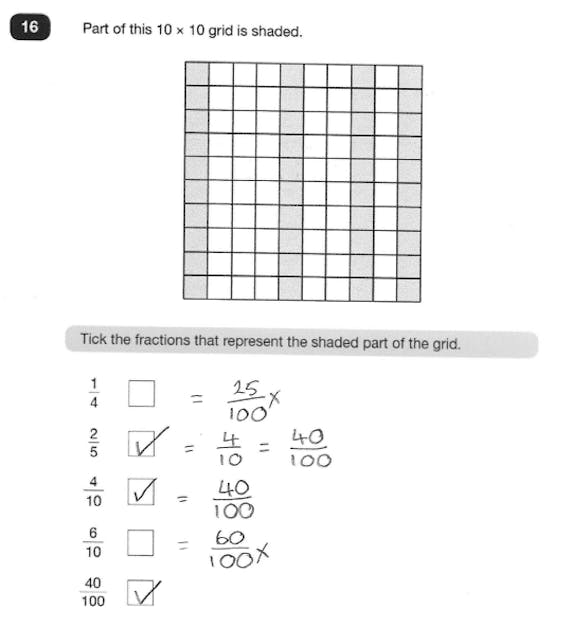
Weights and Measures Questions
Weights and measures questions can be related to time, money, shape, mass, and capacity.
Popular questions involve comparing and contrasting, converting between different measurement units, estimating, reading scales accurately, and solving practical problems.
Examples include:
- 2016 KS2 Maths Paper 2: 9, 11, 15.
- 2016 KS2 Maths Paper 3: 3, 10, 14, 17.
- 2017 KS2 Maths Paper 2: 7, 13, 19, 21.
- 2017 KS2 Maths Paper 3: 5, 10, 14, 20, 24.
- 2018 KS2 Maths Paper 2: 3, 17, 22.
- 2018 KS2 Maths Paper 3: 11, 13, 20, 21.
- 2019 KS2 Maths Paper 2: 7, 11b, 17, 19, 23.
- 2019 KS2 Maths Paper 3: 4, 6, 7a, 12, 14, 15, 16.
- 2022 KS2 Maths Paper 2: 5, 6, 10, 12, 23.
- 2022 KS2 Maths Paper 3: 3, 10, 14, 17, 21.
How to Answer Weights and Measures Questions
- Read the question carefully.
- Check which units are used in the question, e.g., kg, cm or litres, and which units are required for the answer.
- If there is a diagram, look at labels and any scales used and make a note of any readings.
- Use the information given to solve the problem.
- If needed, convert between the units given and the units required for the answer.
- Write the answer clearly in the box provided.
Example Weights and Measures Questions Question
Taken from 2018 KS2 Maths SATs Paper 3, Question 11.
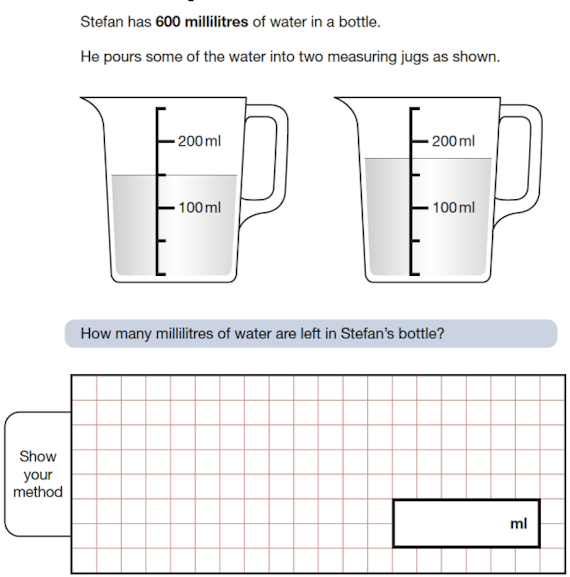
How to answer:
- Make a note of the volume of liquid you start with and the units it is measured in – 600ml.
- Take the readings from each jug: 150ml and 175ml.
- Make sure the units are the same: they are both ml.
- Add the volumes of water in both jugs: 150 + 175 = 325ml.
- Subtract the volume of water in the jugs from the original volume: 600 – 325 = 275ml.
- Record the remaining volume in the box provided.
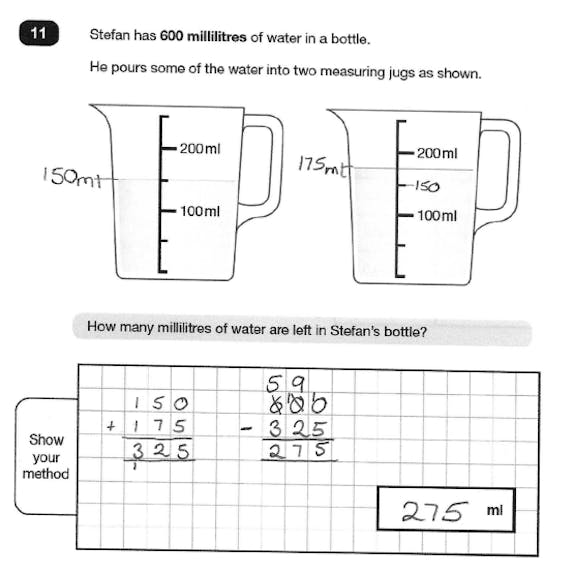
Statistics and Data Questions
Statistics and data questions usually require children to read information from a chart or table and perform comparison calculations with the data. For example, children may be expected to find the difference between two or more pieces of data, calculate the mean or calculate a missing value.
Examples include:
- 2016 KS2 Maths Paper 2: 4.
- 2016 KS2 Maths Paper 3: 9.
- 2017 KS2 Maths Paper 2: 1, 4.
- 2017 KS2 Maths Paper 3: 4, 6, 9.
- 2018 KS2 Maths Paper 2: 5, 18.
- 2018 KS2 Maths Paper 3: 6.
- 2019 KS2 Maths Paper 2: 15, 22.
- 2019 KS2 Maths Paper 3: 7, 9.
- 2022 KS2 Maths Paper 2: 9, 13.
- 2022 KS2 Maths Paper 3: 6, 20.
How to Answer Statistics and Data Questions
- Check the scales or keys as they may be critical to answering the question.
- Carefully read and record any data that you need to use.
- Complete any calculations required.
- Always show your working – you may get a mark even if you make an arithmetic error.
- Record your answer in the space provided.
Example Statistics and Data Question
Taken from 2022 KS2 Maths SATs Paper 3, Question 20.
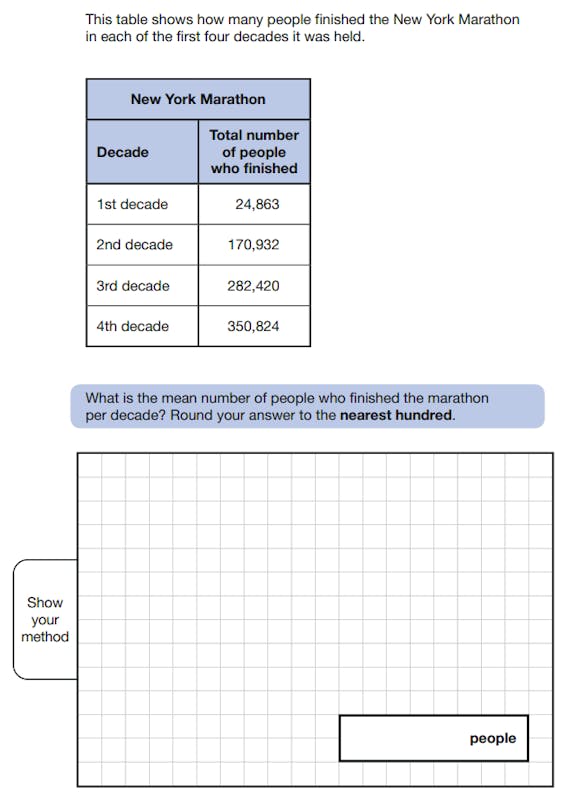
How to answer:
- To find the mean, add up the number of people who finished and divide by the number of decades.
- To add the data, it is generally recommended to use the column method of addition. This will total 829,039.
- Divided this total by the number of decades. 829,039 ÷ 4 = 207,259.8.
- Round the number to the nearest hundred. 207,259.8 rounded to the nearest hundred is 207,300.
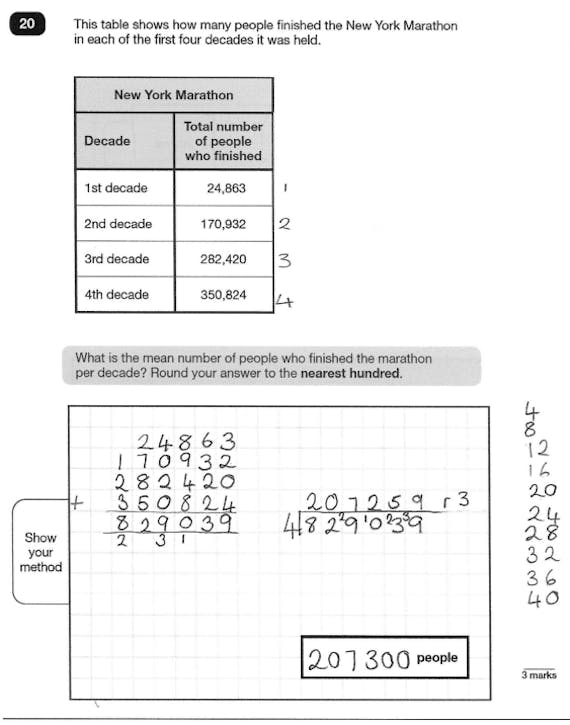
Summary
- Spend plenty of time practising mental arithmetic - it's key to KS2 Maths and there is an entire SATs paper dedicated to it.
- The Maths SATs papers feature a number of question types that come up every year.
- Four of these question types are: mental arithmetic, fractions, decimals and percentages, weights and measures, and statistics and data.
- By reading our answering strategies and example answers, your child can improve their answering technique, scoring more in their KS2 Maths SATs papers.
- Practise makes perfect for KS2 Maths so make sure your child tackles plenty of practice questions.
